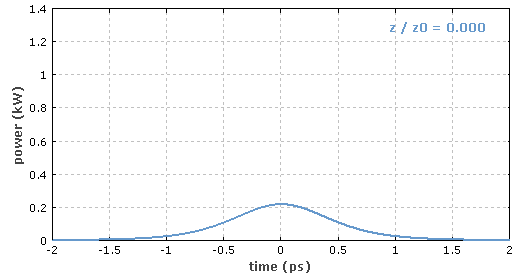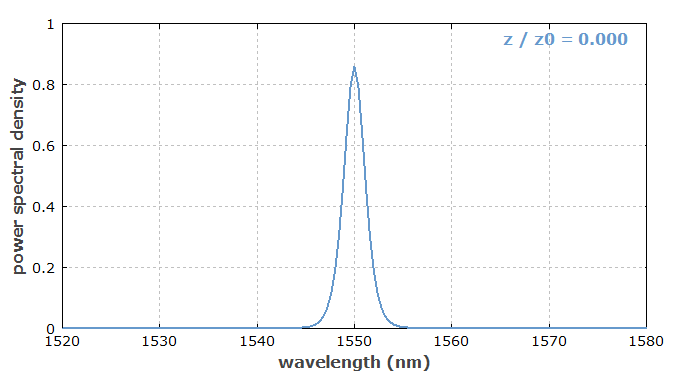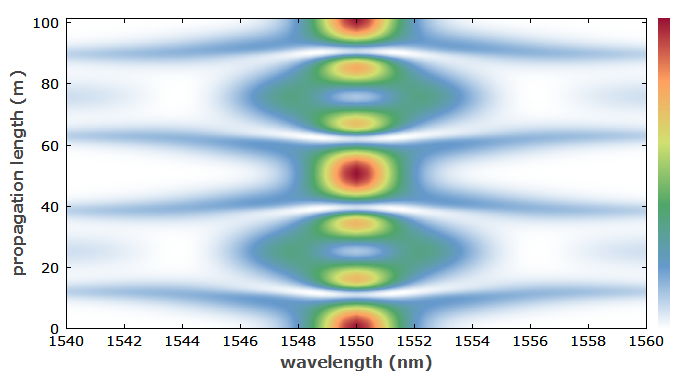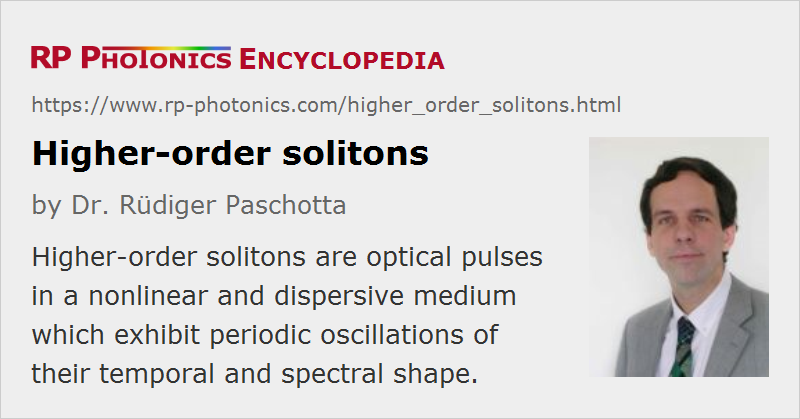Higher-order Solitons
Definition: optical pulses in a nonlinear and dispersive medium which exhibit periodic oscillations of their temporal and spectral shape
More general term: solitons
German: Solitonen höherer Ordnung
Categories: fiber optics and waveguides, light pulses
How to cite the article; suggest additional literature
Author: Dr. Rüdiger Paschotta
A fundamental soliton is an optical pulse which can propagate in a dispersive medium (e.g. an optical fiber) with a constant shape of the temporal intensity profile, i.e., without any temporal broadening as is usually caused by dispersion. This can happen when the pulse has a certain shape and an energy which is determined by the parameters of the medium (in particular, by the dispersion and nonlinearity) and the pulse duration.
A higher-order soliton is a soliton pulse the energy of which is higher than that of a fundamental soliton by a factor which is the square of an integer number (i.e. 4, 9, 16, etc.). The temporal shape of such a pulse is not constant, but rather varies periodically during propagation (see Figures 1 and 2). The period of their evolution is the so-called soliton period.




Higher-order solitons can be used for nonlinear pulse compression: a sech2-shaped pulse with a suitable energy, injected into an optical fiber with anomalous dispersion, can evolve as a higher-order soliton, and after a certain propagation distance the pulse duration can be substantially decreased. High soliton orders allow for strong compression, but also lead to a critical choice of the pump wavelength.
Whereas fundamental solitons are usually fairly stable, higher-order solitons can break up into fundamental solitons under the influence of various effects, such as higher-order dispersion, Raman scattering, or two-photon absorption. Such soliton breakup sometimes plays an essential role in the process of supercontinuum generation in photonic crystal fibers.
Questions and Comments from Users
Here you can submit questions and comments. As far as they get accepted by the author, they will appear above this paragraph together with the author’s answer. The author will decide on acceptance based on certain criteria. Essentially, the issue must be of sufficiently broad interest.
Please do not enter personal data here; we would otherwise delete it soon. (See also our privacy declaration.) If you wish to receive personal feedback or consultancy from the author, please contact him e.g. via e-mail.
By submitting the information, you give your consent to the potential publication of your inputs on our website according to our rules. (If you later retract your consent, we will delete those inputs.) As your inputs are first reviewed by the author, they may be published with some delay.
Bibliography
| [1] | V. E. Zakharov and A. B. Shabat, “Exact theory of two-dimensional self-focusing and one-dimensional self-modulation of waves in nonlinear media”, Sov. Phys. JETP 34, 62 (1972) |
| [2] | L. F. Mollenauer, R. H. Stolen, and J. P. Gordon, “Experimental observation of picosecond pulse narrowing and solitons in optical fibers”, Phys. Rev. Lett. 45 (13), 1095 (1980), doi:10.1103/PhysRevLett.45.1095 |
| [3] | W. Hodel and H. P. Weber, “Decay of femtosecond higher-order solitons in an optical fiber induced by Raman self-pumping”, Opt. Lett. 12 (11), 924 (1987), doi:10.1364/OL.12.000924 |
| [4] | S. R. Friberg and K. W. DeLong, “Breakup of bound higher-order solitons”, Opt. Lett. 17 (14), 979 (1992), doi:10.1364/OL.17.000979 |
See also: solitons, soliton period
and other articles in the categories fiber optics and waveguides, light pulses
 |




If you like this page, please share the link with your friends and colleagues, e.g. via social media:
These sharing buttons are implemented in a privacy-friendly way!